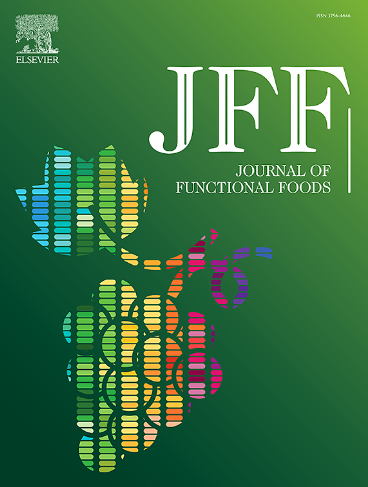芙蓉对肥胖哮喘大鼠体成分和气道反应性的保护作用
IF 4
2区 农林科学
Q2 FOOD SCIENCE & TECHNOLOGY
引用次数: 0
摘要
肥胖会加重哮喘症状并降低治疗效果,这突出了传统上用于肥胖管理的芙蓉(HS)作为肥胖加重哮喘治疗的潜力。本研究评估HS是否可以预防肥胖加重哮喘Wistar大鼠的体成分、气道功能和反应性变化。雄性大鼠按250、500、1000 mg/kg剂量分为对照组(Ctrl)、肥胖哮喘组(Ob + ash)和hs处理组。大鼠接受了16周的高血糖饮食,并在最后22天对卵清蛋白敏感。在最后30天内口服HS。体内评估包括体重、空腹血糖、体重指数和肺通气,而体外测试测量了气管收缩、肺和脂肪组织形态学。HS可防止体重增加,降低血糖和脂肪,减少脂肪细胞大小,限制气管高反应性和支气管血管周围炎症。这些发现支持HS作为治疗肥胖加重哮喘的有希望的选择。本文章由计算机程序翻译,如有差异,请以英文原文为准。

Protective effects of Hibiscus sabdariffa L. on body composition and airway reactivity in obese asthmatic rats
Obesity worsens asthma symptoms and reduces treatment response, highlighting the potential of Hibiscus sabdariffa (HS), traditionally used for obesity management, as a treatment for obesity-exacerbated asthma. This study evaluated whether HS could prevent body composition, airway function, and reactivity changes in Wistar rats with obesity-exacerbated asthma. Male rats were divided into control (Ctrl), obese asthmatic (Ob + Asth), and HS-treated groups at 250, 500, and 1000 mg/kg. Rats received a high-glycemic diet for 16 weeks and were sensitized to ovalbumin in the last 22 days. HS was administered orally in the last 30 days. In vivo assessments included weight, fasting glucose, body mass index, and pulmonary ventilation, while in vitro tests measured tracheal contraction and lung and adipose histomorphometry. HS prevented weight gain, reduced glucose and adiposity, decreased adipocyte size, and limited tracheal hyperreactivity and peribronchovascular inflammation. These findings support HS as a promising option for treating obesity-exacerbated asthma.
求助全文
通过发布文献求助,成功后即可免费获取论文全文。
去求助
来源期刊

Journal of Functional Foods
FOOD SCIENCE & TECHNOLOGY-
CiteScore
9.60
自引率
1.80%
发文量
428
审稿时长
76 days
期刊介绍:
Journal of Functional Foods continues with the same aims and scope, editorial team, submission system and rigorous peer review. We give authors the possibility to publish their top-quality papers in a well-established leading journal in the food and nutrition fields. The Journal will keep its rigorous criteria to screen high impact research addressing relevant scientific topics and performed by sound methodologies.
The Journal of Functional Foods aims to bring together the results of fundamental and applied research into healthy foods and biologically active food ingredients.
The Journal is centered in the specific area at the boundaries among food technology, nutrition and health welcoming papers having a good interdisciplinary approach. The Journal will cover the fields of plant bioactives; dietary fibre, probiotics; functional lipids; bioactive peptides; vitamins, minerals and botanicals and other dietary supplements. Nutritional and technological aspects related to the development of functional foods and beverages are of core interest to the journal. Experimental works dealing with food digestion, bioavailability of food bioactives and on the mechanisms by which foods and their components are able to modulate physiological parameters connected with disease prevention are of particular interest as well as those dealing with personalized nutrition and nutritional needs in pathological subjects.
 求助内容:
求助内容: 应助结果提醒方式:
应助结果提醒方式:


